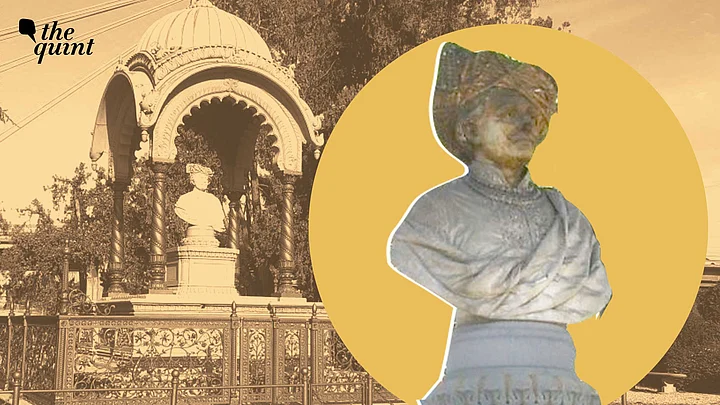"So I listened to the voices
Of the river of Florence
As if before I had been told
What I was now listening to"
- Pablo Neruda
There's a park in Florence, Italy called Le Cascine, flanking the country and, a small square that people familiarly call 'the Indian'.
It is the extreme western offshoot of the Cascine Park, a destination for romantic walks that until a few years ago was open in the field guard building. There's also a bridge nearby inaugurated in 1978, called the 'Bridge of the Indian', referring to the small square and the monument standing on it.
A bust under a canopy is the 'Monument to the Indian Prince', designed by Architect Charles Mant. The bust, on the other hand, was sculpted by the Artist Charles Francis Fuller.
Why did they, however, bother putting in so much effort for an Indian prince? And who is 'the Indian' in Florence?
The 'Monument to the Indian Prince' is acknowledged and appreciated only by the locals while foreigners have no idea of it. It is a long-forgotten story that has stood the test of time.
Let's go back to Florence dated 30 November 1870. A few lines in the La Nazione, a regional daily, read:
"On Tuesday morning, after a brief illness, he passed away in Florence at the grand Locanda della Pace, where he had taken a room with his retinue, His Royal Highness Rajah Maharaja of Kolhapur (a city located in Southwest Maharashtra). He was attended by Professors Ghinozzi, Cipriani, and Wilson but despite the indefatigable and intelligent care given to him by the distinguished physicians, he succumbed at the age of 20."La Nazione
His Royal Highness' name was Rajaram Chuttraputti, and that was his first trip abroad. He had stopped in Paris first, two nights at Hotel de Lille, which did not give him time to see everything: the Tuileries, the Boulevards, the Bois the Boulogne, or Napoleon's tomb at the Dome des Invalides.
The young Rajaram kept a diary, where he dutifully journalled his trip: the ferry across the English Channel, his arrival in London, his mansion near Hyde Park, the trips to the cotton mills and to Shakespeare's plays, the lectures at the Royal Geographical Society, the Oxford University libraries, and even Madam Tussaud's museum. The fireworks, Kew Gardens, and hunting matches were also mentioned, along with the clubs, and the visits to Westminster, records the diary of a young boy, albeit a sensible one, but of a boy nevertheless.
It was published later in England under the title, "Diary of the Late Rajah of Kolhapur, During His Visit to Europe in 1870."
According to his entries, Rajaram fell ill in Inverness, while en route Italy. But the illness "did not at first seem sufficiently serious to cause any alarm." In Venice, he was well enough to be carried in a sedan chair to see the Palace of the Doges and the Piazza di San Marco, and it was not until the arrival of the party in Florence that the plan of going via Rome and Naples to Brindisi was canceled. At Florence, the Rajah consulted an English physician, under whose treatment he seemed to be getting on well.
A change for the worse, however, suddenly came on. Two of the leading Italian practitioners were called into consultation by Dr Fraser, and for a time, the patient appeared to rally, but on the morning of 30 November, he suddenly died.
His death was attributed to "congestion of the abdominal viscera, together with the collapse of nervous power". His funeral remained in the memory of those who had the chance to see it as it found its place in the stories of the city.
Again, La Nazione had a full reportage of that night. Rajaram had a Hindu funeral in Florence and was cremated on the banks of the river Arno, the spot where it meets the river Mugnone.
The procession started at night from the Locanda della Pace. The Maharaja was dressed in his finery, with a red silk turban and a pearl necklace worth, according to La Nazione, 50,000 francs. The procession was followed by Captain West, Rajaram's English tutor, and by all the local authorities. A small crowd of locals who had never seen anything of the likes also looked on.
At the time, the funeral seemed very odd, but it opened the first political debate in Florence, and then across Italy, about cremation, a practice that had always been banned primarily for religious reasons. Four years later, Rajaram's mother arrived in Florence to thank the authorities for allowing the proper funeral rites of her son and asked for a monument to be built in his memory.
The domed canopy that contains that exotic bust, in perpetual memory of the red-turbaned young man depicted by Fuller with the same dress that he wore for his funeral, immediately attracted the attention and curiosity of the population.
Eventually, people made a habit of having their pictures taken right next to the mausoleum which was inaugurated in 1874.
The various faces of the cube supporting the marble bust bear an inscription in four different languages—Italian, Hindi, English, and Punjabi. In time, people started calling that place 'the Indian', which inspired the name of the nearby bridge as well. And this is how Kolhapur secured a place in the hearts and minds of Florence.
(Francesca Marino is a journalist and a South Asia expert who has written ‘Apocalypse Pakistan’ with B Natale. Her latest book is ‘Balochistan — Bruised, Battered and Bloodied’. She tweets @francescam63. This is an opinion piece and the views expressed are the author's own. The Quint neither endorses nor is responsible for his reported views.)
(At The Quint, we question everything. Play an active role in shaping our journalism by becoming a member today.)
